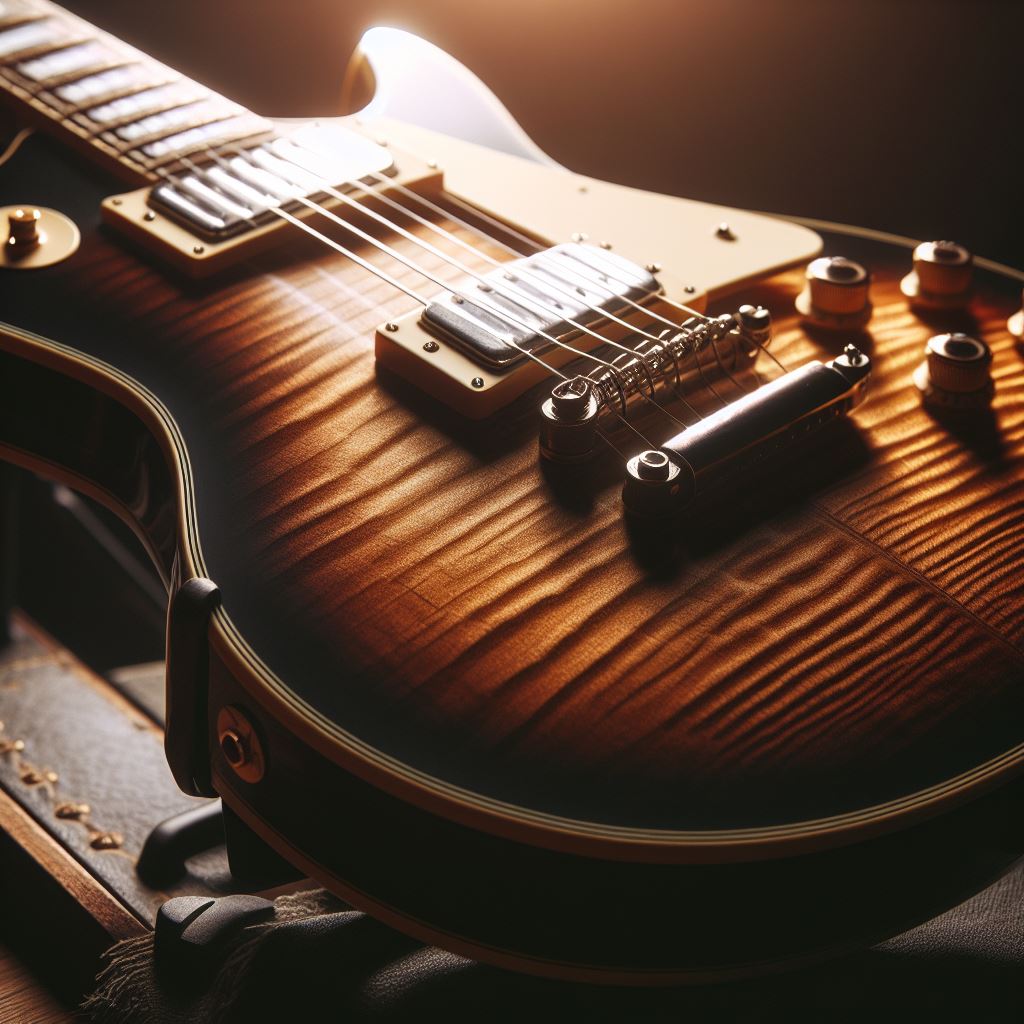Before diving into the technicalities of guitar tuning, it’s crucial to grasp the basics of guitar tuning. Tuning ensures that each string on your guitar produces the correct pitch, enabling you to play harmoniously with other instruments and in different musical styles. The standard tuning for a six-string guitar is E-A-D-G-B-E, from the lowest (thickest) string to the highest (thinnest) string. This is referred to as standard tuning and is the most common tuning method used by beginner and professional guitarists alike.
Understanding how to tune your guitar is foundational for any guitarist. Without proper tuning, your chords and notes will sound off, making it difficult to play along with recordings or other musicians. Tuning can be done through various methods, including electronic tuners, tuning apps, or by ear using reference pitches.
Electronic tuners are the most precise and are highly recommended for beginners. They work by detecting the frequency of the string and indicating whether you need to tighten or loosen it. Tuning apps offer similar functionality and can be a convenient option if you have a smartphone. Tuning by ear requires a bit more skill but can be mastered with practice.
Be sure to subscribe to my YouTube channel for more in-depth tutorials and tips on guitar tuning and maintenance. Mastering the basics of tuning is your first step toward becoming a proficient guitarist.
Standard Tuning for Guitars

When it comes to learning how to tune a guitar, standard tuning is the go-to method for most guitarists. Standard tuning refers to the pitch each string is tuned to, starting from the lowest (thickest) string to the highest (thinnest) string. These pitches are E, A, D, G, B, and E. This arrangement has been universally adopted because it allows for a wide range of chords and scales to be played with relative ease.
Each string in standard tuning is tuned to a specific pitch:
- 6th string (E): The lowest-pitched string, also known as the low E string.
- 5th string (A): The second lowest-pitched string.
- 4th string (D): The middle string in terms of pitch.
- 3rd string (G): The third highest-pitched string.
- 2nd string (B): The second highest-pitched string.
- 1st string (E): The highest-pitched string, also known as the high E string.
To tune your guitar to standard tuning, you can use an electronic tuner, a tuning app, or even tune by ear if you have a reference pitch. Most electronic tuners and tuning apps will have a standard tuning setting, making it easy to get each string to the correct pitch. If you’re tuning by ear, you can use a piano, another guitar, or an online tuning guide as your reference.
Standard tuning is essential for beginners because it sets the foundation for learning chords, scales, and songs. Once you’re comfortable with standard tuning, you’ll find it much easier to explore other tuning methods and styles of play.
Alternate Guitar Tuning Methods

While standard tuning is the most widely used method, exploring alternate guitar tuning methods can open up a world of new sounds and creative possibilities. Alternate tunings change the pitch of some or all of the strings, resulting in different chord voicings and tonal qualities that can inspire new musical ideas.
Here are some popular alternate tuning methods:
- Drop D Tuning: In this tuning, the 6th string (low E) is tuned down a whole step to D. This results in a D, A, D, G, B, E configuration, which is popular in rock and metal for its heavier sound.
- DADGAD Tuning: Known for its use in Celtic and folk music, this tuning lowers the 6th string to D, the 2nd string to A, and the 1st string to D, resulting in D, A, D, G, A, D. It creates a droning sound that is both rich and full.
- Open G Tuning: This tuning is achieved by tuning the 6th string to D, the 5th string to G, and the 1st string to D, resulting in D, G, D, G, B, D. Open G is favored by blues and slide guitarists for its resonant, open chords.
- Open D Tuning: In this tuning, the 6th string is tuned to D, the 5th string to A, the 3rd string to F#, the 2nd string to A, and the 1st string to D, resulting in D, A, D, F#, A, D. It’s commonly used in folk and blues for its deep, rich sound.
Experimenting with alternate tunings can be a fun and rewarding experience, as it allows you to discover new chord shapes and melodic patterns. Many famous guitarists, such as Joni Mitchell and Keith Richards, have used alternate tunings to create iconic songs. By stepping out of the standard tuning comfort zone, you can unlock a new dimension of creativity in your playing.
Using a Guitar Tuner Effectively

When it comes to keeping your guitar in tune, a guitar tuner is an indispensable tool for both beginners and seasoned players. Knowing how to use a guitar tuner effectively can ensure that your instrument sounds its best, whether you’re practicing at home or performing on stage.
Here are some tips for getting the most out of your guitar tuner:
- Choose the Right Tuner: There are several types of guitar tuners available, including clip-on tuners, pedal tuners, and smartphone apps. Clip-on tuners attach to the headstock and detect vibrations, making them ideal for noisy environments. Pedal tuners are great for live performances, as they can mute your signal while tuning. Smartphone apps are convenient and often free, but may not be as accurate as dedicated tuners.
- Ensure a Quiet Environment: If you’re using a tuner that relies on a built-in microphone, make sure you’re in a quiet environment to avoid interference from background noise. This will help the tuner detect the pitch of your strings more accurately.
- Tune One String at a Time: Pluck one string at a time and let it ring out. The tuner will display the pitch of the note, and you can adjust the tuning pegs accordingly. It’s important to tune slowly and make small adjustments to avoid over-tightening or loosening the string too much.
- Check Your Tuning Regularly: Guitars can go out of tune due to changes in temperature, humidity, and playing style. Make it a habit to check your tuning regularly, especially before a performance or recording session.
- Use Harmonics for Fine-Tuning: For more precise tuning, you can use harmonics. Lightly touch the string at the 12th fret and pluck it to produce a harmonic note. The tuner will pick up this clearer, more stable pitch, allowing for finer adjustments.
By following these tips, you can ensure that your guitar is always in perfect tune, enhancing your playing experience and making your music sound its best. Remember, a well-tuned guitar is the foundation of great music, so take the time to tune up before you play.
Tuning a Guitar by Ear

Tuning a guitar by ear is a valuable skill that every guitarist should develop. While electronic tuners are convenient and highly accurate, being able to tune by ear not only trains your auditory skills but also ensures you can always get your instrument in tune, regardless of the setting or available tools.
Here are some steps and tips to help you master tuning a guitar by ear:
- Reference Pitch: Start with a reference pitch. This could be a tuning fork, a pitch pipe, or another instrument that’s already in tune. The most common reference pitch is the open A string (440 Hz).
- Tune the A String: Once you have your reference pitch, tune your fifth string (A string) to match it. Pluck the string and adjust the tuning peg until the pitch matches the reference note.
- Fifth Fret Method: Use the fifth fret method to tune the remaining strings. For the low E string, press down on the fifth fret and match the pitch to the open A string. For the D string, press the fifth fret on the A string and match the pitch. Repeat this process for the G string, using the D string as your reference.
- Fourth Fret for the B String: The B string is an exception. To tune it, press the fourth fret on the G string and match the pitch to the open B string.
- Return to Fifth Fret for High E: Finally, return to the fifth fret method for the high E string. Press the fifth fret on the B string and match the pitch to the open high E string.
- Check and Adjust: Once all strings are tuned, go back and check each string again, as adjusting one string can sometimes affect the others. Make any necessary minor adjustments to ensure perfect tuning.
Developing the ability to tune by ear takes practice and patience, but it’s a rewarding skill that will improve your overall musicianship. Over time, you’ll find that your ear becomes more attuned to pitch variations, making it easier to keep your guitar sounding great.
Common Guitar Tuning Issues and Solutions
Even seasoned guitarists encounter tuning issues, which can be frustrating if not addressed correctly. Understanding common guitar tuning issues and their solutions is crucial for maintaining your instrument’s optimal sound quality.
Here are some typical tuning problems and how to fix them:
- String Slippage: Strings that slip at the tuning pegs can cause your guitar to go out of tune quickly. Make sure the strings are properly wound around the tuning pegs. A good rule of thumb is to have at least three wraps around the peg for each string.
- Temperature and Humidity: Changes in temperature and humidity can affect your guitar’s wood, causing it to expand or contract, which in turn affects tuning. Store your guitar in a stable environment and consider using a humidifier during dry seasons.
- Old Strings: Worn-out strings lose their ability to hold tension and stay in tune. Regularly changing your strings can help keep your guitar sounding fresh and maintain tuning stability.
- Nut Issues: If the strings are binding in the nut slots, they may not return to pitch after bending or tuning. Applying a small amount of graphite from a pencil to the nut slots can help lubricate them and prevent binding.
- Bridge and Saddle Problems: Misaligned or poorly adjusted bridges and saddles can cause intonation issues. Ensure that your bridge and saddle are properly adjusted and, if necessary, consult a professional for fine-tuning.
- Tuning Pegs: Loose or faulty tuning pegs can also cause tuning instability. Check that your tuning pegs are tight and functioning correctly. If they are worn out, consider replacing them.
Addressing these common issues will help you maintain consistent tuning and improve your overall playing experience. Remember, a well-maintained guitar not only stays in tune better but also enhances your performance.
Subscribe To My YouTube Channel for more in-depth tutorials, gear reviews, and tips to enhance your guitar-playing journey. Visit us at jonathansturgill.com to stay updated!

